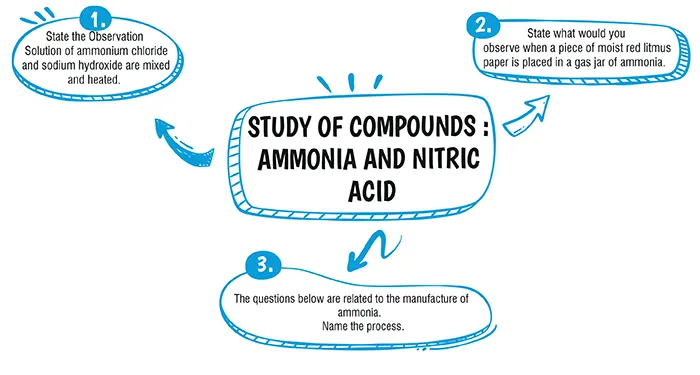Table of Contents

Ans. (a) Yellowish-green colour disappears
Explanation:
When excess ammonia reacts with yellowish-green chlorine gas then a two-step reaction takes place. The end product is ammonium chloride which has white fumes.
Ans. (d) N_2\text{ and H}_2
Explanation:
The Haber process is used for manufacturing ammonia gas on an industrial level. It utilises nitrogen and hydrogen gas for the production of ammonia.
Explanation:
Ammonia gas is produced when ammonium chloride (NH_4Cl) and sodium hydroxide (NaOH) is heated.
\\2NH_4Cl + NaOH → NaCl + H_2O + NH_3 ↑
Explanation:
When a moist piece of red litmus is placed in a gas jar containing ammonia, the ammonia will dissolve in the water of the litmus paper and turn into ammonium hydroxide, which is an alkali. The red litmus paper will then turn blue.
Explanation:
(i) The process used to manufacture ammonia is known as Haber's process.
(ii) One part of nitrogen by volume reacts with three parts of hydrogen by volume.
(iii) Finely divided iron is used as a catalyst.
(iv) The required equation is
N_2+3H_2→2NH_3+Heat\\(v) The reducing action of ammonia is demonstrated by
\\3PbO+2NH_3→3Pb+3H_2O+N_2
Download Mind Map of this chapter
Download NowWant to Practice Mock Tests of this chapter
Practice NowDownload Important Questions of this chapter
Download Now| Chapter No. | Chapter Name |
|---|---|
| Chapter 1 | Periodic Properties and Variations of Properties |
| Chapter 2 | Chemical Bonding |
| Chapter 3 | Study of Acids, Bases and Salts |
| Chapter 4 | Analytical Chemistry |
| Chapter 5 | Mole concept and Stoichiometry |
| Chapter 6 | Electrolysis |
| Chapter 7 | Metallurgy |
| Chapter 8 | Study of Compounds : Hydrogen Chloride |
| Chapter 9 | Study of Compounds : Ammonia and Nitric Acid |
| Chapter 10 | Study of Compounds : Sulphuric Acid |
| Chapter 11 | Organic Compounds |
| Chapter Wise Important Questions for ICSE Board Class 10 Chemistry |
|---|
| Periodic Properties and Variations of Properties |
| Chemical Bonding |
| Study of Acids, Bases and Salts |
| Analytical Chemistry |
| Mole concept and Stoichiometry |
| Electrolysis |
| Metallurgy |
| Study of Compounds : Hydrogen Chloride |
| Study of Compounds : Ammonia and Nitric Acid |
| Study of Compounds : Sulphuric Acid |
| Organic Compounds |
CBSE Important Questions Class 10
ICSE Important Questions Class 10
CBSE Important Questions Class 10
ICSE Important Questions Class 10